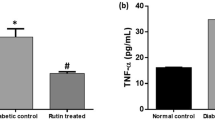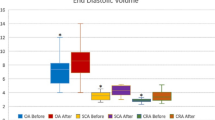Abstract
The prevalence of Diabetes mellitus has increased around the world in the last decade. Anyone with diabetes is at risk of diabetic eye complications. The aim of the study was to compare effects of standardized Ginkgo biloba (Ginkgo biloba L.) dry extract (Ex.Gb) with the placebo on the microcirculation lesions of the eye in randomized double-blind placebo-controlled trial. 44 patients with type 2 diabetes mellitus were randomized to Ex.Gb 160 mg per day or placebo, and were followed up for nine months. Dose of Ex.Gb was increased to 240 mg in next nine months. Total Antioxidant Status (TAS) of plasma was measured using the Trolox equivalent antioxidant capacity assay. Ophthalmologic examination was performed by the biomicroscopic method. Vascular, intravascular and perivascular alterations were evaluated, and total conjunctival index was calculated. Though the values of the total conjunctival index and its constituent decreased (P<0.05) during the study in Ex.Gb group, there were no significant differences between these parameters as compared with placebo group. Evaluation of plasma TAS showed gradually increment, although insignificant and very small, in Ex.Gb group. The significance of Ex.Gb on development of the alterations of eye microcirculation, especially in elder patients needs to be explored further.
Similar content being viewed by others
Abbreviations
- ABTS:
-
2,2-Azino-di-(3-ethylbenzthiazoline sulphonate)
- DM:
-
Diabetes mellitus
- DR:
-
Diabetic retinopathy
- Ex.Gb:
-
standardized Ginkgo biloba (Ginkgo biloba L.) dry extract
- HbA1c:
-
Glycated hemoglobin
- IVC:
-
Index of the intravascular changes
- PVC:
-
Index of the perivascular changes
- TAS:
-
Total Antioxidant Status
- TCI:
-
Total conjunctival index
- VC:
-
Index of the vascular changes
References
International Diabetes Federation, One adult in ten will have diabetes by 2030, Press Release — World Diabetes Day, Brussels 2011, http://www.idf.org/media-events/press-releases/2011/diabetes-atlas-5th-edition
International Diabetes Federation, Europe’s children top the global diabetes stakes, Press Release — World Diabetes Day, Brussels 2011, http://www.idf.org/sites/default/files/6.EURPress-Release-WDD.pdf
Kowluru R.A., Chan P.S., Oxidative Stress and Diabetic Retinopathy, Exp. Diabetes Res. 2007, 2007:43603
International Diabetes Federation, Fact sheet: Diabetes and eye disease, 2011, http://www.idf.org/fact-sheets/diabetes-eye-disease
Fowler M.J., Microvascular and Macrovascular Complications of Diabetes, Clin. Diabetes, 2008, 26(2), 77–88
Moricke R., Die Beurteilung degenerativer Gefassprozesse an der terminalen Strombahn der Conjuctiva bulbi mit einem Konjunktival index. Innere Medizin, Leipzig, 1973, 2, 32–36 (in German)
Miniauskiene G., Jasinskas V., Association of metabolic syndrome with abnormalities of bulbar conjunctival vessels, Medicina, 2008, 44(2), 100–109
Danilova Al., Microcirculatory disorder in the bulbar conjunctiva of patients with diabetic retinopathy, Probl Endokrinol (Mosk), 1986, 32(5), 18–22
Baynes J.W., Thorpe S.R., Role of Oxidative Stress in Diabetic Complications: A New Perspective on an Old Paradigm, Diabetes, 1999, 48(1), 1–9
Bashan N., Kovsan J., Kachko I., Ovadia H., Rudich A., Positive and negative regulation of insulin signaling by reactive oxygen and nitrogen species, Physiol Rev., 2009, 89(1), 27–71
Jay D., Hitomi H., Griendling K.K., Oxidative stress and diabetic cardiovascular complications, Free Radic. Biol. Med., 2006, 40(2), 183–192
Pitocco D., Zaccardi F., Stasio E., Romitelli F., Santini S.A., Zuppi C., et al., Oxidative Stress, Nitric Oxide, and Diabetes, Rev. Diabet. Stud., 2010, 7(1), 15–25
Fong D.S., Aiello L.P., Ferris F.L., Klein R., Diabetic Retinopathy, Diabetes Care, 2004, 27(10), 2540–2553
Giacco F., Brownlee M., Oxidative stress and diabetic complications, Circ. Res., 2010, 107(9), 1058–1070
E/S/C/O/P Monographs, The Scientific Foundation for Herbal Medicinal Products, 2003, pp.178–210
Barnes J., Anderson L.A., Phillipson J.D., Herbal Medicines Second edition. Pharmaceutical Press, 2002, pp. 250–263.
Rahman K., Studies on free radicals, antioxidants, and co-factors, Clin. Interv. Aging., 2007, 2(2), 219–236
Stefek M., Natural flavonoids as potential multifunctional agents in prevention of diabetic cataract, Interdiscip. Toxicol., 2011, 4(2), 69–77
Kudolo G.B., Delaney D., Blodgett J., Short-term oral ingestion of Ginkgo biloba extract (EGb 761) reduces malondialdehyde levels in washed platelets of type 2 diabetic subjects, Diabetes Res. Clin. Pract., 2005, 68, 29–38
Nijveldt R.J., Nood E., Hoorn D.E.C., Boelens P.G., Norren K., Leeuwen, P.A.M., Flavonoids: a review of probable mechanisms of action and potential applications, Am. J. Clin. Nutr., 2001, 74(4), 418–425.
Ferrali M., Signorini C., Caciotti B., Sugherini L., Ciccoli L., Giachetti D., et.al., Protection against oxidative damage of erythrocyte membrane by the flavonoid quercetin and its relation to iron chelating activity, FEBS Lett., 1997, 416, 123–129
Ritch R., Potential role for Ginkgo biloba extract in the treatment of glaucoma, Med. Hypotheses., 2000, 54(2), 221–235
Cybulska-Heinrich A.K., Mozaffarieh M., Flammer J., Ginkgo biloba: An adjuvant therapy for progressive normal and high tension glaucoma, Mol. Vis., 2012, 18, 390–402
Kudolo G.B., The effect of 3-month ingestion of Ginkgo biloba extract on pancreatic beta-cell function in response to glucose loading in normal glucose tolerant individuals, J. Clin. Pharmacol., 2000, 40, 647–654
Lanthony P., Cosson J.P., The course of color vision in early diabetic retinopathy treated with ginkgo biloba extract. A preliminary, double-blind versus placebo study, J. Fr. Ophtalmol., 1988, 11, 71–674
Chung H.S., Harris A., Kristinsson J.K., Ciulla T.A., Kagemann C., Ritch, R., Ginkgo biloba extract increases ocular blood flow velocity, J. Ocul. Pharmacol. Ther., 1999, 15, 233–240
Lee D.J., Ahn H.B., Rho S.H., The effect of Ginkgo biloba to retinal microcirculation, J. Korean Ophthalmol. Soc., 2002, 43, 1522–1527
Miller N.J., Rice-Evans C., Davies M.J., Gopinathan V., Milner A., A novel method for measuring antioxidant capacity and its application to monitoring the antioxidant status in premature neonates, Clin. Sci., 1993, 84, 407–412
Author information
Authors and Affiliations
Corresponding author
About this article
Cite this article
Spadiene, A., Savickiene, N., Jurgeviciene, N. et al. Effect of ginkgo extract on eye microcirculation in patients with diabetes. cent.eur.j.med 8, 736–741 (2013). https://doi.org/10.2478/s11536-012-0146-1
Received:
Accepted:
Published:
Issue Date:
DOI: https://doi.org/10.2478/s11536-012-0146-1




